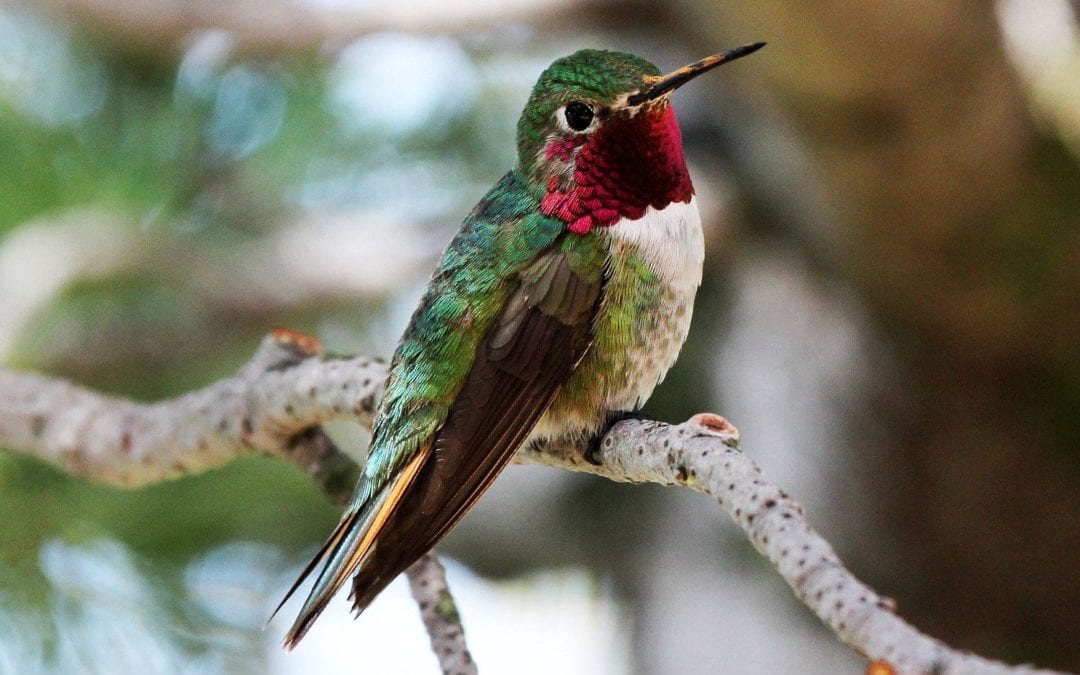Our Perennial Buyer saw this spring’s first Ruby-throated Hummingbirds just a couple of days ago. They zoomed past her cats on their way to a fuschia she had conveniently brought home that day. We haven’t seen any at the Garden Center yet, but should now that it’s warm enough for the hanging baskets to be outside. Hummingbirds usually make their appearance in early May, so they are right on target after a few years of earlier arrivals.
It’s always thrilling to glance out your window and spot a hummingbird scouting your garden. My very first thought is always “How can I get these magical little birds interested in my garden?” The key to creating habitats that will attract hummingbirds, or any wildlife to your yard, is variety. You should have areas of sun and shade, differing heights of vegetation, clean water and lots of flowers. Try to choose plants that will be blooming at different times so that there is always something colorful. These blossoms will provide nectar for visiting hummingbirds.
A hummingbird’s tiny heart beats 1260 times a minute! They often rest between feeding and will perch on high dead tree branches that offer the open visibility that hummingbirds prefer. And all birds appreciate the security that small shrubs and large perennials provide. This provides shelter in bad weather and hiding places from predators.
As they whiz around your garden, hummingbirds expend so much energy that they must eat at least half their body weight every day to replace the 12,000 calories that they burn. They eat constantly, from sunrise to sunset. Tube-shaped blossoms hold more nectar, making them the most attractive. You can provide these flowers in a variety of ways Plant perennials such as foxglove, coralbells and hollyhock, and shrubs or vines, like weigela, summersweet and trumpetvine. Containers of annuals will work, too. Try fuchsia or red salvia.
Although hummingbirds are very attracted to the color red, they will check out most any brightly-colored flower. You can always find a spot for more perennials. Intensely hued phlox and bee balms bloom in late spring to early summer, while butterflybush and globe thistle are in flower later in the season.
If your yard is particularly spatially challenged, and what self-respecting plant geek’s isn’t, or if you only have a terrace or balcony, plant a container. A pot filled with upright giant blue sage, mounding pentas and trailing million bells will act as a hummingbird magnet, and satisfy all of those rules of container design.
A few words about feeders. Be sure to put your feeders out right away to ensure that the birds see them, stop for a snack and decide to stay. It’s also a good idea to hang several in different parts of your garden. Hummingbirds, males especially, can be very territorial about their feeders. Clean them often, especially if they’re located in the sun.
There have been some news about the effect of artificially-dyed hummingbird nectar. Reports from regular observers and wildlife rescue agencies reference hummingbirds that have difficulty or are unable to fly. Our Birding Buyer assures me that the red nectar mixes in the Garden Center are colored with natural red hibiscus blossoms, and will not harm any hummingbirds.
Another item that she is really excited about is the Humm-Bug, a hummingbird protein feeder. This contained structure can be loaded with banana peels or other old fruit that attracts fruit flies. The flies congregate around the feeder and the hummingbirds have a constant source of protein-rich food.
So acquaint yourself with the habits of hummingbirds and coax them into your garden. Once you’ve seen them hovering over your perennial border in the early morning, or dive bombing your golden retriever, you’ll be hooked.


